#Shopify product data scraper
Text
How To Enhance E-Commerce Excellence With The Power Of A Shopify Scraper?
Optimize e-commerce success with a Shopify Scraper. Extract real-time insights, enhance decisions, and streamline operations, all powered by comprehensive data extraction from Shopify listings.
#Shopify scraper#Shopify data scraping#Shopify product data scraper#webscrapingdatafromecommerce#e-commerce data scraping service#e-commerce data scraper
0 notes
Text

Use our Shopify product data Scraper to Scrape Shopify product data of online stores. use it in Canada, USA, UK, etc., to scrape title, and description, and other data.
0 notes
Text
What Role Does E-commerce Web Scraping Play in Market Research Strategies
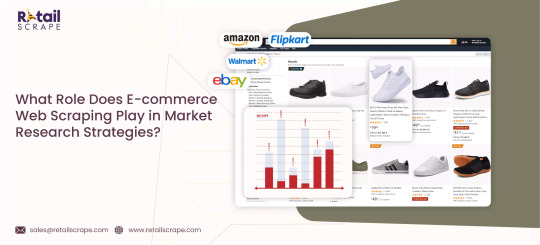
In the dynamic domain of E-commerce, securing a competitive advantage depend on data-centric decision-making. E-commerce web scraping emerges as an indispensable tool, facilitating businesses to glean invaluable insights from the expansive digital marketplace. Seamlessly extracting real-time data encompassing product prices, competitor tactics, customer feedback, and market dynamics, web scraping empowers enterprises to swiftly adapt, refine pricing strategies, and fortify market positioning. In this era dominated by digital commerce, the significance of E-commerce web scraping cannot be overstated; it serves as the cornerstone for well-informed decision-making in the perpetually evolving online commerce landscape. This blog intricately explores the realm of E-commerce web scraping, elucidating the process and the necessity for coding expertise. By harnessing the power of E-commerce web scraping, businesses can unlock a wealth of actionable insights, propelling them toward sustained success amidst the ever-shifting currents of digital trade.
About E-Commerce Web Scraping
Scraping ecommerce data is an essential method explicitly tailored to gather valuable insights from various online platforms. This approach helps scrape ecommerce data pertinent to pricing patterns, product availability, and customer feedback, providing businesses with a holistic comprehension of market dynamics. By serving as a potent ecommerce data extractor, this technique enables companies to drive informed decisions, fine-tune pricing tactics, and uphold a competitive advantage in the perpetually shifting market terrain. By systematically collecting ecommerce data, businesses secure a strategic edge, ensuring adaptability and optimization in online commerce's dynamic and fiercely competitive realm.
How To Create an E-commerce Scraper?
Here's a step-by-step guide on how to create an e-commerce data scraper:
Identify the Target Website: Determine which e-commerce website(s) you want to scrape. Choose a popular platform with structured data to simplify the scraping process. Common examples include Amazon, eBay, and Shopify-based stores.
Understand the Website Structure: Analyze the website structure you're targeting. Identify the HTML elements that contain the product information you want to scrape, such as product name, price, description, and images.
Choose a Web Scraping Tool or Library: Select a web scraping tool or library that suits your programming language preference and requirements. Popular choices include BeautifulSoup (Python), Scrapy (Python), or Puppeteer (JavaScript). Ensure the tool supports features like handling JavaScript rendering if the target site heavily relies on it.
Set Up Your Development Environment: Install the chosen web scraping tool or library and any necessary dependencies. Create a new project directory and set up your development environment.
Set Up Your Development Environment:
Begintract data from the target website, begin writing code
Use the chosen library's documentation and tutorials to navigate through the scraping process
Write functions to navigate through web pages, locate relevant HTML elements, and extract desired data
Handle Pagination and Dynamic Content: Many e-commerce websites paginate their product listings or load content dynamically via JavaScript. Implement logic in your scraper to handle pagination and dynamic content loading to ensure you retrieve all relevant data.
Test Your Scraper:
Test your scraper on a small subset of data to ensure it functions correctly.
Check for any errors, such as missing data or incorrect formatting.
Adjust your code as needed to address any issues that arise during testing.
Monitor and Maintain Your Scraper: E-commerce websites may periodically update their structure or implement measures to prevent scraping. Monitor your scraper's performance over time and adjust as necessary to adapt to any changes. Regularly maintain your scraper to ensure it fetches accurate and up-to-date data from the target website(s).
Following these steps, you can create an effective e-commerce scraper to extract product data from your target website(s). Remember to respect the website's terms of service and use your scraper responsibly and ethically.
Significance of Scraping E-commerce Data
Scraping e-commerce data is essential in business operations, market analysis, and consumer insights. Here's a detailed breakdown of the significance of collecting e-commerce data:
Competitive Analysis:
By web scraping e-commerce data, businesses can analyze their competitors' product offerings, pricing strategies, and marketing tactics.
Understanding competitors' product assortments and pricing helps businesses adjust their strategies to stay competitive.
Market Research:
E-commerce data collection enables businesses to conduct comprehensive market research by analyzing trends, consumer preferences, and demand patterns.
Identifying emerging trends and popular products helps businesses make informed decisions regarding product development, inventory management, and marketing campaigns.
Price Monitoring and Optimization:
Extracting e-commerce data allows businesses to monitor the prices of products across different platforms in real-time.
Price optimization strategies, such as dynamic pricing, can be implemented based on insights from e-commerce data collection to maximize revenue and maintain competitiveness.
Inventory Management:
E-commerce data scraping services help businesses optimize inventory levels by tracking product availability, stock movements, and demand fluctuations.
Accurate inventory management ensures that businesses can meet customer demand efficiently while minimizing overstocking or stockouts.
Sales Forecasting:
Analyzing historical e-commerce data enables businesses to accurately forecast future sales trends and demand patterns.
Sales forecasts from e-commerce data collection help businesses allocate resources effectively, plan promotional activities, and optimize inventory levels.
Consumer Insights and Personalization:
Scraping e-commerce data provides valuable insights into consumer behavior, preferences, and purchasing patterns.
Businesses can use this information to personalize marketing messages, recommend products, and enhance customers' overall shopping experience.
Brand Monitoring and Reputation Management:
E-commerce data collection allows businesses to monitor mentions of their brand across various platforms, including customer reviews and social media.
Monitoring brand sentiment and addressing customer feedback helps businesses maintain a positive reputation and build customer trust.
Fraud Detection and Risk Management:
By analyzing e-commerce data, businesses can detect fraudulent activities, such as fake reviews, counterfeit products, and payment fraud.
Implementing robust fraud detection mechanisms based on insights from e-commerce data collection helps businesses mitigate risks and safeguard their operations.
Thus, scraping e-commerce data is crucial in driving business growth, enhancing competitiveness, and improving decision-making across various domains, including marketing, sales, operations, and risk management. It empowers businesses with valuable insights to stay ahead in today's dynamic e-commerce landscape.
Conclusion
Harnessing the potential of E-commerce web scraping offers unparalleled opportunities to extract valuable data crucial for business success. By leveraging scraping techniques, businesses can access a wealth of information, including product details, pricing trends, and consumer behavior insights. This data empowers informed decision-making, allowing dynamic pricing strategies, targeted marketing campaigns, and enhanced competitiveness. With the right tools and approach, E-commerce web scraping becomes a powerful asset, enabling businesses to stay ahead in the fast-paced online marketplace. Embracing the power of scraping ensures businesses have the insights needed to thrive and adapt in an ever-evolving e-commerce landscape.
Leverage the power of data-driven decisions with our Retail Scrape Company. Utilize consumer behavior insights, fine-tune pricing strategies, and surge ahead of competitors with real-time retail data scraping. Elevate your business with our comprehensive pricing optimization solutions and strategic decision support. Reach out today to revolutionize your retail ventures and maximize profits!
know more :
https://www.retailscrape.com/ecommerce-web-scraping-market-research-strategies.php
#Market Research Strategies Scraping#Web Scraping MarketResearch Strategies#Scrape Market Research Strategies#Market Research Strategies Collection#EcommerceWebScraping
0 notes
Text
The Game-Changers in Dropshipping: Top Product Research Tools Unveiled
If you're navigating the intricate world of dropshipping, you know the paramount importance of finding those elusive 'winning products.' Today, I'm diving into some of the most innovative product research tools that are reshaping the dropshipping landscape. Whether you're a seasoned pro or just starting, these tools are your ticket to a more streamlined, successful e-commerce journey.
1. Niche Scraper - The Insightful Prodigy
Niche Scraper is a powerhouse in the realm of product research. Its advanced algorithm delves deep into e-commerce platforms, spotlighting top-selling items with minimal effort. Key features like its product video finder and Facebook Ad Spy tool provide a holistic approach to not just product discovery, but also enhancing your advertising campaigns.
2. Pexda - The Trendsetter
Pexda stands out with its ability to pinpoint trending products, offering comprehensive ad intelligence and direct links to suppliers. With its varied pricing plans, it caters to businesses of all sizes, offering insights on cost, potential selling price, and profit projections.
3. Sell The Trend - The Comprehensive Solution
Sell The Trend is a treasure trove of features including 'The Nexus' for product discovery, Facebook Ads examples, and Shopify store showcases. Its AI Brand Builder and Order Management Assistance tools are particularly noteworthy for automating and streamlining the dropshipping process.
4. AliExpress Dropshipping Center - The Cost-Effective Champion
For those on a budget, the AliExpress Dropshipping Center is a free tool offering essential product research capabilities and analytical tools to vet products before listing. Its no-cost nature makes it a popular choice among new entrants.
5. SaleSource - The Market Maven
SaleSource offers robust product analysis, competitor insights, and AI-powered trend analysis. With flexible pricing plans, it's tailored to fit various business needs and budgets, making it an attractive option for businesses at different stages.
6. Dropship - The Innovative Brainchild
Founded in 2020, Dropship provides a vast Product Database and a unique portfolio of prospective winning products, updated weekly. It stands out for its competitor insights and user-friendly interface, despite being slightly on the higher end in terms of pricing.
7. Ecomhunt - The Curated Genius
Ecomhunt excels in offering an extensive product library and a free account option. It provides rich product data for each listing, aiding in informed decision-making.
Choosing Your Ally
While independent product research is valuable, these tools provide a shortcut to discovering optimal products and understanding market trends. They are more than just product finders; they offer insights into competition and market dynamics, giving you a strategic edge.
Remember, the right tool can significantly streamline your process and boost your chances of success in the dropshipping arena.
0 notes
Text
How To Enhance E-Commerce Excellence With The Power Of A Shopify Scraper
How To Enhance E-Commerce Excellence With The Power Of A Shopify Scraper?

Shopify is a renowned e-commerce platform enabling businesses to create and manage online stores easily. It offers a user-friendly interface, customizable templates, and a range of features to facilitate seamless online retail operations. Businesses opt for Shopify due to several compelling reasons:
Ease of Use: Shopify requires no coding expertise, enabling even non-technical users to set up and manage an online store effortlessly.
Versatility: It caters to various business sizes and industries, from startups to established enterprises, offering adaptable tools and solutions.
Customization: Shopify's extensive theme library and app ecosystem allow businesses to personalize their stores' appearance and functionality.
Secure Transactions: The platform provides secure payment gateways, protecting customer data and financial transactions.
Scalability: As businesses grow, Shopify accommodates their needs by offering scalable plans and features that support increased traffic and sales.
Mobile Optimization: Shopify's responsive design ensures seamless shopping experiences across devices, catering to the rising mobile commerce trend.
Integrated Marketing Tools: It integrates marketing tools, SEO optimization, and social media capabilities, facilitating effective promotion and customer engagement.
Robust Support: Shopify offers customer support, extensive documentation, and a vibrant community, assisting businesses in troubleshooting and maximizing platform use.
Introduction to Shopify Scraping

Shopify data scraping means extracting valuable data and information from Shopify's online stores using automated tools or software. This technique enables businesses and individuals to gather product details, pricing, inventory information, customer reviews, and other relevant data from Shopify listings.
The primary purpose of Shopify scraping is to obtain actionable insights that can drive informed decision-making in e-commerce operations. By collecting and analyzing data from Shopify stores, businesses can gain a competitive edge, enhance their product offerings, optimize pricing strategies, improve inventory management, and develop more effective marketing campaigns.
Data extraction plays a pivotal role in the realm of e-commerce. In today's digital landscape, where online shopping is pervasive, having access to accurate and up-to-date data is paramount. E-commerce businesses rely on data-driven insights to understand market trends, monitor competitor activities, anticipate customer demands, and tailor their strategies accordingly.
In this context, Shopify scraping emerges as a powerful tool that empowers businesses to harness the vast amount of information available in Shopify stores. By leveraging scraped data, businesses can make well-informed decisions, enhance customer experiences, and ultimately achieve tremendous success in the dynamic world of online retail.
About Shopify Scraper

A Shopify scraper is a specialized tool or software designed to extract valuable data and information from Shopify's e-commerce platform. It automates gathering details such as product listings, prices, descriptions, images, inventory levels, customer reviews, and other relevant data from Shopify stores.
A Shopify scraping tool aims to provide businesses and individuals with actionable insights that can inform and optimize their e-commerce strategies. By collecting and analyzing data from Shopify, users can gain a competitive advantage by understanding market trends, monitoring competitor activities, improving pricing and inventory management, and enhancing customer engagement.
Web data scraper play a crucial role in data-driven decision-making within the e-commerce landscape. They enable businesses to streamline operations, improve customer experiences, and drive growth by leveraging the information available on Shopify's platform. As online retail continues to evolve, a e-commerce data scraping tool becomes an indispensable tool for those seeking to thrive in the dynamic and competitive world of e-commerce.
Significant Features of Shopify Scraper

Key features of a Shopify scraper include:
Data Extraction: The Shopify data API efficiently collects product information, including titles, descriptions, prices, images, reviews, and inventory details.
Real-time Updates: It provides access to real-time and up-to-date data, ensuring decision-making accuracy.
Customizable Search Parameters: Users can define specific criteria such as categories, keywords, and price ranges for targeted data extraction.
Competitor Analysis: It allows businesses to analyze competitor strategies, pricing, and product offerings.
Price Optimization: Users can make informed pricing decisions by tracking and comparing prices across different listings.
Inventory Management: It aids in managing inventory levels by monitoring availability and stock quantities.
Trend Identification: Users can identify emerging market trends and popular products through scraped data.
Customer Insights: Analyzing customer reviews and ratings provide insights into customer sentiments and preferences.
Data Export: Export the scraped data in various formats, such as JSON, CSV, Excel, or XML, for further analysis.
Automated Scraping: Some Shopify extraction tools offer automation features, allowing scheduled and repeated data extraction.
Ease of Use: A user-friendly interface simplifies setting up and initiating data scraping tasks.
Support and Updates: Quality scrapers offer customer support and regular updates to ensure functionality and adaptability.
Tips to Choose the Right Shopify Scraper
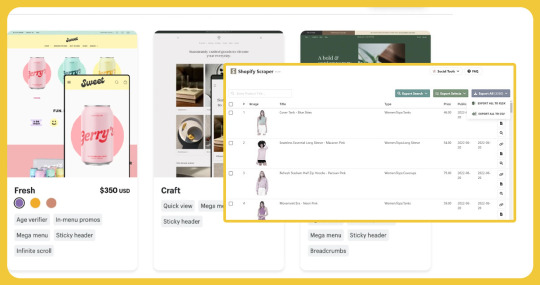
The proper Shopify product data scraper is pivotal for successful data extraction and informed decision-making. Here are essential tips to guide your selection process:
Data Accuracy: Prioritize a scraper that guarantees accurate, up-to-date data to ensure the reliability of your insights.
Customization Flexibility: Opt for an e-commerce data scraper that allows tailored data extraction by defining specific parameters like product categories, keywords, and pricing ranges.
User-Friendly Interface: Select a tool with an intuitive interface for easy setup, task initiation, and monitoring.
Real-time Updates: Ensure that it offers real-time data extraction capabilities to provide the latest information for your analyses.
Data Formats: Choose the one that supports export formats (e.g., JSON, CSV, Excel) compatible with your analysis tools.
Scalability: Consider the ability of e-commerce data scraping tool to handle growing data volumes as your business expands.
Support and Updates: Prioritize a shopify data scraping tool with reliable customer support and regular updates to address issues and adapt to platform changes.
User Reviews and Reputation: Research user reviews and gauge the e-commerce data scraping services reputation to assess its performance, reliability, and user satisfaction.
Legal Compliance: Ensure the scraper adheres to legal and ethical scraping practices, respecting platform terms of use.
Cost-effectiveness: Balance the features with its cost to ensure it aligns with your budget and expected ROI.
Compatibility: Verify compatibility with your operating system and existing tools to avoid technical issues.
Trial Period or Demo: Opt for E-commerce web scrapers offering a trial period or demo version to evaluate its functionality before committing.
How to Enhance E-Commerce Excellence with the Power of a Shopify Scraper?

A Shopify Scraper can elevate e-commerce excellence through various vital mechanisms:
Informed Decision-Making: By extracting real-time data from Shopify listings, it provides insights into market trends, competitor strategies, and customer preferences. Hence, this informed decision-making drives targeted product offerings and marketing strategies.
Competitive Edge: It enables businesses to closely analyze competitor activities, pricing trends, and product assortments. This information empowers businesses to refine their strategies and stand out in a competitive marketplace.
Optimized Pricing Strategies: Accurate pricing information from the scraper helps businesses set competitive and profitable price points, maximizing revenue while offering value to customers.
Effective Inventory Management: Timely inventory updates obtained through the scraper ensure businesses maintain optimal stock levels. It minimizes overstocking or stockouts, enhancing customer satisfaction and operational efficiency.
Personalized Customer Engagement: Data on customer reviews, ratings, and preferences enables businesses to tailor marketing efforts, leading to higher customer engagement, loyalty, and repeat sales.
Efficient Product Development: It can identify popular products, emerging trends, and gaps in the market, guiding businesses to develop innovative products aligned with customer demands.
Strategic Marketing Campaigns: The data insights derived can easily craft laser-focused marketing campaigns. It helps deliver the right message to the right audience and boost conversion rates.
Time and Resource Savings: Automating data extraction tasks streamlines operations, freeing up valuable time and resources for strategic planning and growth initiatives.
Conclusion: the Shopify scraper is a pivotal asset in the modern e-commerce landscape, offering businesses an unparalleled opportunity to extract valuable insights and drive informed decision-making. By harnessing the power of data extraction, businesses can gain a competitive edge, optimize pricing strategies, enhance inventory management, and stay attuned to emerging market trends. Seamlessly accessing and analyzing real-time data from Shopify listings empowers businesses to forge a path toward growth and success. As online retail continues to evolve, this tool remains a steadfast tool, providing the means to unlock a more profound understanding and capitalize on the vast opportunities within the dynamic world of e-commerce.
Know More:
https://www.iwebdatascraping.com/enhance-e-commerce-excellence-with--the-power-of-a-shopify-scraper.php
#Shopifydatascraping#shopifydatascrapingtool#Shopifyproductdatascraper#extractdatafromshopify#extractedshopifyproductdata#shopifyproductdataextractionservices
0 notes
Text
Creating and Running a Shopify Scraper: Code-Based and Non-Coding Approaches
'This blog discusses diverse approaches to scraping Shopify, including crafting a Shopify scraper. The objective is to efficiently export Shopify product data to formats like Excel, simplifying access and utilization.'
Know more:
https://www.actowizsolutions.com/creating-and-running-shopify-scraper.php
#ScrapingShopifyProductStores#ShopifyProductDataScraping#ScrapingShopifyProductData#ExtractShopifyProductScraper
0 notes
Text
Advanced Shopify Scraper Techniques: Beyond Basic Data Removal
Shopify, having its myriad of businesses and wealthy troves of knowledge, has turned into a tempting goal for data fanatics, scientists, and even competitors. It's resulted in the emergence and reputation of Shopify scrapers. But what exactly is Shopify scraping? So how exactly does it work? And what are the ethical considerations? Let's search in to it. shopify scraper
What's Shopify Scraper?
At their core, a Shopify scrape is really a tool or a software program made to remove data from Shopify stores. This can vary from product facts, pricing, client evaluations, to any information shown publicly on a Shopify store. Scrapers perform by moving the web site as a visitor could, but rather of displaying this content, they obtain the main knowledge and save it in a organized type, such as CSV or Excel.
Why Could Somebody Work with a Shopify Scrape?
Market Study: Businesses might want to realize the market landscape, item pricing methods, or customer preferences.
Competitive Evaluation: Maintaining tabs on competitors' products, prices, and stock may give corporations an edge.
Knowledge Collection for Unit Learning: Data researchers and researchers would use crawled data for teaching device understanding models.
Tendency Examination: By regularly scraping data, it's possible to discover tendencies, such as the increase and fall of specific services and products or brands.
The Aspects of Scraping
A normal Shopify scrape performs in the next way:
Request and Result: The scraper sends a request to the Shopify keep, similar to what a browser does. The server then directs right back the answer, typically in HTML format.
Parsing: The obtained HTML material is then parsed to extract the desired data.
Information Storage: The produced information is kept in a organized structure, ready for examination or other uses.
Navigation: Advanced scrapers can also steer through numerous pages, manage periods, and even reproduce user interactions.
The Honest and Appropriate Criteria
While scraping offers immense potential, it's perhaps not without its challenges.
Permission: Several sites, including Shopify, have phrases of service that restrict scraping. Skipping these can result in appropriate issues.
Overloading Machines: Repeated and intense scraping requests may clog the host, affecting the website's performance.
Solitude Considerations: Scraping private data, even though it's publicly available, can violate solitude principles and rules, like GDPR.
To scrape ethically:
Always refer to the website's robots.txt file, which outlines what can and cannot be scraped.
Limit demand prices to avoid overloading servers.
Always respect solitude principles and regulations.
Realization
Shopify scraping, like any tool, comes with its group of pros and cons. When performed ethically and responsibly, it can provide a wealth of information. However, it's necessary to be conscious of permissions and possible appropriate ramifications. While the electronic earth develops and evolves, therefore may the equipment and methods, which makes it all the more critical to navigate the landscape responsibly.
0 notes
Text
Niche Scraper - Reveal winning products with our powerful niche research bot.

Niche Scraper Review:
Start Finding Winning Products TodayThe Niche Scraper is an extremely powerful dropshipping and product research bot. It allows you to spy on other Shopify sites and find guaranteed winning products. Take the guess work out of your research and allow our web crawler to show you products that are proven to sell.
Features of Niche Scraper:
FE - Niche Scraper - $19
- Unlimited access to hand picked products with:
- - Facebook Ad Reports
- - Targeting Suggestions
- - AliExpress Reports
- - Suppliers
- Unlimited access to the Facebook video ad tool.
- Scrape a store's best selling products.
- Reveal estimated revenue of other stores.
- Monthly subscription.
- Access to our exclusive dropshipping community.
- Easy cancellation at any time.
Product Scraper
- Tired of searching the millions of products on AliExpress and Shopify for potential winners? Our product scraper analyzes thousands of products each day to show you which have the highest dropshipping potential.
Store Analysis
- Store analysis lets you spy on other top stores to reveal their best selling products, traffic data, sales estimates, and more. Gain a competitive edge by understanding the market.
Hand Picked
- A curated list of winning products hand picked every day with suppliers, ad examples and more! A great starting point for store owners who want to hit the ground running.
Video Maker
- Create high converting product videos for your ads in seconds. Just paste your product link and you're set! Perfect for testing product ads quickly and effectively.
Niche Scraper Price:
Current Plan - Free
- Limited access to all products and tools.
- 3 day delay on new winning hand picked products.
- Limited access to the Facebook video ad generator.
- Limited access to exclusive dropshipping guides.
- Cannot block others from spying on your store.
Monthly PRO Membership - $49.95 / Month
- Discover trending products on AliExpress.
- Unlimited access to the Facebook video maker tool.
- Scrape a store's best selling products.
- Reveal estimated revenue of other stores.
- Unlimited access to hand picked products with:
- *Facebook Ad Reports
- *Targeting Suggestions
- *AliExpress Reports
- *Suppliers
- Monthly subscription.
- Easy cancellation at any time.
Annual PRO Membership - $199.00 / Year
- Discover trending products on AliExpress.
- Unlimited access to the Facebook video maker tool.
- Scrape a store's best selling products.
- Reveal estimated revenue of other stores.
- *Unlimited access to hand picked products with:
- *Facebook Ad Reports
- *Targeting Suggestions
- *AliExpress Reports
- *Suppliers
- Yearly subscription.
- Easy cancellation at any time.
Niche Scraper Discount:
- 1- Clear Your cookies in your Web Browser before using DemonVsRobot bonuses link, to make sure you will get all bonuses
- 2- Verify you see 996321 at the bottom of the checkout page
-
- 3- After completing your order , send in a message to my FB Account at: https://m.me/DemonVsRobot or Send a mail to [email protected]
- 4- You will receive all theses bonuses within 24 hours.
Read the full article
0 notes
Text
How to Deal With Alibaba Scraping Challenges as well as Scrape Required Data?

Alibaba is the marketplace that connects manufacturers as well as businesses. As a leading wholesale website, it is a well-known data source for online entrepreneurs. Therefore, Alibaba scraping is utilized for getting suppliers, monitor prices and stocks, making product catalogs, as well as different other tasks.
In this blog, we’ll observe data types that could be extracted from Alibaba as well as methods of searching relevant data. Furthermore, we’ll share tips about how to make a well-structured file made for particular job.
Challenges While Extracting Alibaba
This marketplace is a venture of Alibaba group of companies. Just like all the sites of Alibaba group, this marketplace is well-known for its strict anti-scraping actions:
CAPTCHA
Changing this website’s markup often
IP address blocking in case a crawler is acknowledged as a bot
Retailgators Scraper is the data scraping service, which takes all the challenges off you. This service scrapes data from Alibaba as you’re your specifications as well as offers you a ready-to-utilize file.
What Product And Seller Information Can Be Scraped From Alibaba?
Retailgators Scraper can scrape any texts on the page, which you observe in the browser. The bot would automatically click links and buttons to increase drop-downs, follow sub-pages as well as open pop ups for scraping data from them. Just go through a sample of extracted product named “Women’s Rain jacket” having all accessible details:
In case you need particular fields, you could list them in an order form:
Product Name
Pricing
Image
Product Link
Minimum Orders
Seller’s Name
Seller’s Response Rate
Total Years as a Seller on Alibaba
In Which Formats Alibaba Extracted Data Could Be Presented?
The Retailgators Scraper prepares data in a format, which best suits a task. Therefore, for analyses of extracted suppliers or product data you may need to find data in Google Sheets or a CSV file. While, if you want to import extracted Alibaba listing, you might need a file formatted for particular shopping cart needs.
To get an e-commerce-friendly format for WooCommerce, Shopify, Magento, or PrestaShop, shopping cart specify that in an order form. The file would get tailored for shopping cart as well as have all the necessary fields for smooth import. Here is the sample of WooCommerce products file:
You could import this received file straight into online store for creating or updating products.
How To Search Alibaba For Scraped Data?
You might do different kinds of searches as per your task:
Search by keyword or product. Enter different product ideas in search field.
Search by company. Just enter a complete company name and get suppliers you want.
Search by supplier. In case, you have a few manufacturers in notice, enter the complete factory name.
When you complete the search, copy URL from browser as well as paste that in a request form.
How To Order Web Scraping From Alibaba.Com?
Request a test file for free. Using this form, list fields, which you want, offer the URL or sellers, keywords, or category to scrape data from. State file format as well as email for which a file has to be sent.
You would get an email having attached files once email scraping gets completed. Review a sample file as well as inform us in case any changes are required.
After approval of a file structure, we would send you a job quote so that you can choose a suitable price plan.
After making the payment, you’ll get a complete listing through email, Google Sheets, or FTP.
For more information about Alibaba scraping services, contact Retailgators or ask for a free quote!
#Extract Alibaba Products Data#Alibaba data extractor#Scrape Alibaba Products Data#Scrape data from alibaba
0 notes
Text
Shopify Product Data Scraper | Scrape Data from Shopify

Use our Shopify product data Scraper to Scrape Shopify product data of online stores. use it in Canada, USA, UK, etc., to scrape title, and description, and other data.
0 notes
Text
What Role Does E-commerce Web Scraping Play in Market Research Strategies

In the dynamic domain of E-commerce, securing a competitive advantage depend on data-centric decision-making. E-commerce web scraping emerges as an indispensable tool, facilitating businesses to glean invaluable insights from the expansive digital marketplace. Seamlessly extracting real-time data encompassing product prices, competitor tactics, customer feedback, and market dynamics, web scraping empowers enterprises to swiftly adapt, refine pricing strategies, and fortify market positioning. In this era dominated by digital commerce, the significance of E-commerce web scraping cannot be overstated; it serves as the cornerstone for well-informed decision-making in the perpetually evolving online commerce landscape. This blog intricately explores the realm of E-commerce web scraping, elucidating the process and the necessity for coding expertise. By harnessing the power of E-commerce web scraping, businesses can unlock a wealth of actionable insights, propelling them toward sustained success amidst the ever-shifting currents of digital trade.
About E-Commerce Web Scraping
Scraping ecommerce data is an essential method explicitly tailored to gather valuable insights from various online platforms. This approach helps scrape ecommerce data pertinent to pricing patterns, product availability, and customer feedback, providing businesses with a holistic comprehension of market dynamics. By serving as a potent ecommerce data extractor, this technique enables companies to drive informed decisions, fine-tune pricing tactics, and uphold a competitive advantage in the perpetually shifting market terrain. By systematically collecting ecommerce data, businesses secure a strategic edge, ensuring adaptability and optimization in online commerce’s dynamic and fiercely competitive realm.
How To Create an E-commerce Scraper?

Here’s a step-by-step guide on how to create an e-commerce data scraper:
Identify the Target Website: Determine which e-commerce website(s) you want to scrape. Choose a popular platform with structured data to simplify the scraping process. Common examples include Amazon, eBay, and Shopify-based stores.
Understand the Website Structure: Analyze the website structure you’re targeting. Identify the HTML elements that contain the product information you want to scrape, such as product name, price, description, and images.
Choose a Web Scraping Tool or Library: Select a web scraping tool or library that suits your programming language preference and requirements. Popular choices include BeautifulSoup (Python), Scrapy (Python), or Puppeteer (JavaScript). Ensure the tool supports features like handling JavaScript rendering if the target site heavily relies on it.
Set Up Your Development Environment: Install the chosen web scraping tool or library and any necessary dependencies. Create a new project directory and set up your development environment.
Set Up Your Development Environment:
Begintract data from the target website, begin writing code
Use the chosen library’s documentation and tutorials to navigate through the scraping process
Write functions to navigate through web pages, locate relevant HTML elements, and extract desired data
Handle Pagination and Dynamic Content: Many e-commerce websites paginate their product listings or load content dynamically via JavaScript. Implement logic in your scraper to handle pagination and dynamic content loading to ensure you retrieve all relevant data.
Test Your Scraper:
Test your scraper on a small subset of data to ensure it functions correctly.
Check for any errors, such as missing data or incorrect formatting.
Adjust your code as needed to address any issues that arise during testing.
Monitor and Maintain Your Scraper: E-commerce websites may periodically update their structure or implement measures to prevent scraping. Monitor your scraper’s performance over time and adjust as necessary to adapt to any changes. Regularly maintain your scraper to ensure it fetches accurate and up-to-date data from the target website(s).
Following these steps, you can create an effective e-commerce scraper to extract product data from your target website(s). Remember to respect the website’s terms of service and use your scraper responsibly and ethically.
Significance of Scraping E-commerce Data

Scraping e-commerce data is essential in business operations, market analysis, and consumer insights. Here’s a detailed breakdown of the significance of collecting e-commerce data:
Competitive Analysis:
By web scraping e-commerce data, businesses can analyze their competitors’ product offerings, pricing strategies, and marketing tactics.
Understanding competitors’ product assortments and pricing helps businesses adjust their strategies to stay competitive.
Market Research:
E-commerce data collection enables businesses to conduct comprehensive market research by analyzing trends, consumer preferences, and demand patterns.
Identifying emerging trends and popular products helps businesses make informed decisions regarding product development, inventory management, and marketing campaigns.
Price Monitoring and Optimization:
Extracting e-commerce data allows businesses to monitor the prices of products across different platforms in real-time.
Price optimization strategies, such as dynamic pricing, can be implemented based on insights from e-commerce data collection to maximize revenue and maintain competitiveness.
Inventory Management:
E-commerce data scraping services help businesses optimize inventory levels by tracking product availability, stock movements, and demand fluctuations.
Accurate inventory management ensures that businesses can meet customer demand efficiently while minimizing overstocking or stockouts.
Sales Forecasting:
Analyzing historical e-commerce data enables businesses to accurately forecast future sales trends and demand patterns.
Sales forecasts from e-commerce data collection help businesses allocate resources effectively, plan promotional activities, and optimize inventory levels.
Consumer Insights and Personalization:
Scraping e-commerce data provides valuable insights into consumer behavior, preferences, and purchasing patterns.
Businesses can use this information to personalize marketing messages, recommend products, and enhance customers’ overall shopping experience.
Brand Monitoring and Reputation Management:
E-commerce data collection allows businesses to monitor mentions of their brand across various platforms, including customer reviews and social media.
Monitoring brand sentiment and addressing customer feedback helps businesses maintain a positive reputation and build customer trust.
Fraud Detection and Risk Management:
By analyzing e-commerce data, businesses can detect fraudulent activities, such as fake reviews, counterfeit products, and payment fraud.
Implementing robust fraud detection mechanisms based on insights from e-commerce data collection helps businesses mitigate risks and safeguard their operations.
Thus, scraping e-commerce data is crucial in driving business growth, enhancing competitiveness, and improving decision-making across various domains, including marketing, sales, operations, and risk management. It empowers businesses with valuable insights to stay ahead in today’s dynamic e-commerce landscape.
Conclusion
Harnessing the potential of E-commerce web scraping offers unparalleled opportunities to extract valuable data crucial for business success. By leveraging scraping techniques, businesses can access a wealth of information, including product details, pricing trends, and consumer behavior insights. This data empowers informed decision-making, allowing dynamic pricing strategies, targeted marketing campaigns, and enhanced competitiveness. With the right tools and approach, E-commerce web scraping becomes a powerful asset, enabling businesses to stay ahead in the fast-paced online marketplace. Embracing the power of scraping ensures businesses have the insights needed to thrive and adapt in an ever-evolving e-commerce landscape.
Leverage the power of data-driven decisions with our Retail Scrape Company. Utilize consumer behavior insights, fine-tune pricing strategies, and surge ahead of competitors with real-time retail data scraping. Elevate your business with our comprehensive pricing optimization solutions and strategic decision support. Reach out today to revolutionize your retail ventures and maximize profits!
know more :
https://medium.com/@retailscrape/what-role-does-e-commerce-web-scraping-play-in-market-research-strategies-ff94c28956fe
#E-commerceWebScraping#MarketResearchStrategiesScraping#WebScrapingMarketResearchStrategies#ScrapeMarketResearchStrategies#MarketResearchStrategiesCollection
0 notes
Link
Shopify stores are online e-commerce stores that utilize Shopify to build and personalize their websites. Shopify's e-commerce services are also used by these businesses for product administration, inventory, carts, payments, and shipping. Tesla, ColorPop, The Economist, Skinny Dip London, Gym Shark, and other well-known Shopify stores are just a few examples.
Shopify has simplified the process of setting up an online store and accepting payments for businesses. According to reports, Shopify powers over 500,000 online stores and has generated over $40 billion in revenue.
Most stores are moving their operations online, unlike in the past. The Shopify e-commerce platform is used for more than just physical goods. Digital products, memberships, courses, and rentals are just a few of the options available. Shopify has become a hub for marketers conducting competition research, thanks to the large number of products featured on its sites.
#shopify product data scraping#shopify data scraper#shopify data extraction#shopify data scraper API
0 notes
Text
How To Enhance E-Commerce Excellence With The Power Of A Shopify Scraper
How To Enhance E-Commerce Excellence With The Power Of A Shopify Scraper?
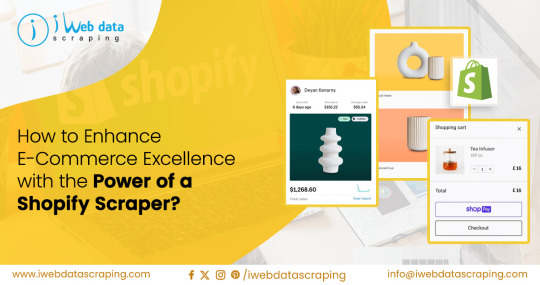
Shopify is a renowned e-commerce platform enabling businesses to create and manage online stores easily. It offers a user-friendly interface, customizable templates, and a range of features to facilitate seamless online retail operations. Businesses opt for Shopify due to several compelling reasons:
Ease of Use: Shopify requires no coding expertise, enabling even non-technical users to set up and manage an online store effortlessly.
Versatility: It caters to various business sizes and industries, from startups to established enterprises, offering adaptable tools and solutions.
Customization: Shopify's extensive theme library and app ecosystem allow businesses to personalize their stores' appearance and functionality.
Secure Transactions: The platform provides secure payment gateways, protecting customer data and financial transactions.
Scalability: As businesses grow, Shopify accommodates their needs by offering scalable plans and features that support increased traffic and sales.
Mobile Optimization: Shopify's responsive design ensures seamless shopping experiences across devices, catering to the rising mobile commerce trend.
Integrated Marketing Tools: It integrates marketing tools, SEO optimization, and social media capabilities, facilitating effective promotion and customer engagement.
Robust Support: Shopify offers customer support, extensive documentation, and a vibrant community, assisting businesses in troubleshooting and maximizing platform use.
Introduction to Shopify Scraping
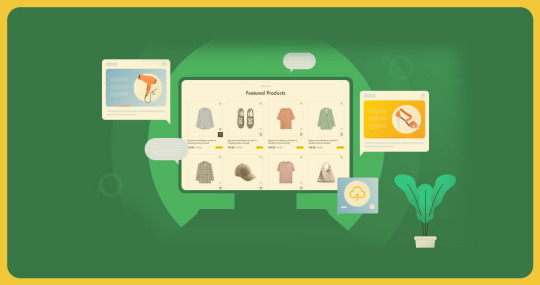
Shopify data scraping means extracting valuable data and information from Shopify's online stores using automated tools or software. This technique enables businesses and individuals to gather product details, pricing, inventory information, customer reviews, and other relevant data from Shopify listings.
The primary purpose of Shopify scraping is to obtain actionable insights that can drive informed decision-making in e-commerce operations. By collecting and analyzing data from Shopify stores, businesses can gain a competitive edge, enhance their product offerings, optimize pricing strategies, improve inventory management, and develop more effective marketing campaigns.
Data extraction plays a pivotal role in the realm of e-commerce. In today's digital landscape, where online shopping is pervasive, having access to accurate and up-to-date data is paramount. E-commerce businesses rely on data-driven insights to understand market trends, monitor competitor activities, anticipate customer demands, and tailor their strategies accordingly.
In this context, Shopify scraping emerges as a powerful tool that empowers businesses to harness the vast amount of information available in Shopify stores. By leveraging scraped data, businesses can make well-informed decisions, enhance customer experiences, and ultimately achieve tremendous success in the dynamic world of online retail.
About Shopify Scraper
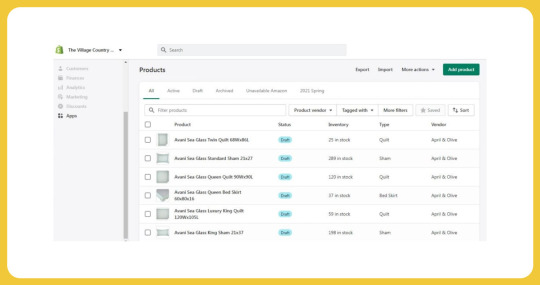
A Shopify scraper is a specialized tool or software designed to extract valuable data and information from Shopify's e-commerce platform. It automates gathering details such as product listings, prices, descriptions, images, inventory levels, customer reviews, and other relevant data from Shopify stores.
A Shopify scraping tool aims to provide businesses and individuals with actionable insights that can inform and optimize their e-commerce strategies. By collecting and analyzing data from Shopify, users can gain a competitive advantage by understanding market trends, monitoring competitor activities, improving pricing and inventory management, and enhancing customer engagement.
Web data scraper play a crucial role in data-driven decision-making within the e-commerce landscape. They enable businesses to streamline operations, improve customer experiences, and drive growth by leveraging the information available on Shopify's platform. As online retail continues to evolve, a e-commerce data scraping tool becomes an indispensable tool for those seeking to thrive in the dynamic and competitive world of e-commerce.
Significant Features of Shopify Scraper

Key features of a Shopify scraper include:
Data Extraction: The Shopify data API efficiently collects product information, including titles, descriptions, prices, images, reviews, and inventory details.
Real-time Updates: It provides access to real-time and up-to-date data, ensuring decision-making accuracy.
Customizable Search Parameters: Users can define specific criteria such as categories, keywords, and price ranges for targeted data extraction.
Competitor Analysis: It allows businesses to analyze competitor strategies, pricing, and product offerings.
Price Optimization: Users can make informed pricing decisions by tracking and comparing prices across different listings.
Inventory Management: It aids in managing inventory levels by monitoring availability and stock quantities.
Trend Identification: Users can identify emerging market trends and popular products through scraped data.
Customer Insights: Analyzing customer reviews and ratings provide insights into customer sentiments and preferences.
Data Export: Export the scraped data in various formats, such as JSON, CSV, Excel, or XML, for further analysis.
Automated Scraping: Some Shopify extraction tools offer automation features, allowing scheduled and repeated data extraction.
Ease of Use: A user-friendly interface simplifies setting up and initiating data scraping tasks.
Support and Updates: Quality scrapers offer customer support and regular updates to ensure functionality and adaptability.
Tips to Choose the Right Shopify Scraper
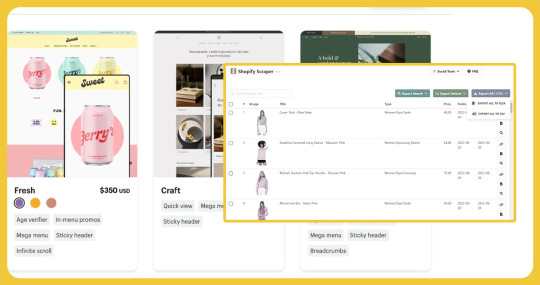
The proper Shopify product data scraper is pivotal for successful data extraction and informed decision-making. Here are essential tips to guide your selection process:
Data Accuracy: Prioritize a scraper that guarantees accurate, up-to-date data to ensure the reliability of your insights.
Customization Flexibility: Opt for an e-commerce data scraper that allows tailored data extraction by defining specific parameters like product categories, keywords, and pricing ranges.
User-Friendly Interface: Select a tool with an intuitive interface for easy setup, task initiation, and monitoring.
Real-time Updates: Ensure that it offers real-time data extraction capabilities to provide the latest information for your analyses.
Data Formats: Choose the one that supports export formats (e.g., JSON, CSV, Excel) compatible with your analysis tools.
Scalability: Consider the ability of e-commerce data scraping tool to handle growing data volumes as your business expands.
Support and Updates: Prioritize a shopify data scraping tool with reliable customer support and regular updates to address issues and adapt to platform changes.
User Reviews and Reputation: Research user reviews and gauge the e-commerce data scraping services reputation to assess its performance, reliability, and user satisfaction.
Legal Compliance: Ensure the scraper adheres to legal and ethical scraping practices, respecting platform terms of use.
Cost-effectiveness: Balance the features with its cost to ensure it aligns with your budget and expected ROI.
Compatibility: Verify compatibility with your operating system and existing tools to avoid technical issues.
Trial Period or Demo: Opt for E-commerce web scrapers offering a trial period or demo version to evaluate its functionality before committing.
How to Enhance E-Commerce Excellence with the Power of a Shopify Scraper?

A Shopify Scraper can elevate e-commerce excellence through various vital mechanisms:
Informed Decision-Making: By extracting real-time data from Shopify listings, it provides insights into market trends, competitor strategies, and customer preferences. Hence, this informed decision-making drives targeted product offerings and marketing strategies.
Competitive Edge: It enables businesses to closely analyze competitor activities, pricing trends, and product assortments. This information empowers businesses to refine their strategies and stand out in a competitive marketplace.
Optimized Pricing Strategies: Accurate pricing information from the scraper helps businesses set competitive and profitable price points, maximizing revenue while offering value to customers.
Effective Inventory Management: Timely inventory updates obtained through the scraper ensure businesses maintain optimal stock levels. It minimizes overstocking or stockouts, enhancing customer satisfaction and operational efficiency.
Personalized Customer Engagement: Data on customer reviews, ratings, and preferences enables businesses to tailor marketing efforts, leading to higher customer engagement, loyalty, and repeat sales.
Efficient Product Development: It can identify popular products, emerging trends, and gaps in the market, guiding businesses to develop innovative products aligned with customer demands.
Strategic Marketing Campaigns: The data insights derived can easily craft laser-focused marketing campaigns. It helps deliver the right message to the right audience and boost conversion rates.
Time and Resource Savings: Automating data extraction tasks streamlines operations, freeing up valuable time and resources for strategic planning and growth initiatives.
Conclusion: the Shopify scraper is a pivotal asset in the modern e-commerce landscape, offering businesses an unparalleled opportunity to extract valuable insights and drive informed decision-making. By harnessing the power of data extraction, businesses can gain a competitive edge, optimize pricing strategies, enhance inventory management, and stay attuned to emerging market trends. Seamlessly accessing and analyzing real-time data from Shopify listings empowers businesses to forge a path toward growth and success. As online retail continues to evolve, this tool remains a steadfast tool, providing the means to unlock a more profound understanding and capitalize on the vast opportunities within the dynamic world of e-commerce.
knowmore:
https://www.iwebdatascraping.com/enhance-e-commerce-excellence-with--the-power-of-a-shopify-scraper.php
#ShopifyScraper#Shopifydatascraping#shopifydatascrapingtool#Shopifyproductdatascraper#extractdatafromshopify#extractedshopifyproductdata#shopifyproductdataextractionservices#ShopifyProductScraper
0 notes
Text
How to Extract a Shopify Product Data within a Few Minutes?

Shopify is amongst the frontrunners for e-commerce sites. It helps newer business owners in creating a fully-operational e-commerce site within a few minutes!
As so many Shopify websites are available, you can extract Shopify websites to scrape Shopify product data, which you can utilize to do:
Competitors’ Analysis
Pricing
Product Development
Research
Today, we’ll exhibit to you how you can extract product data from Shopify websites without using any coding.
Extract Shopify Products Data
Here, we will extract products data from a Shopify Website
Let’s Get Started
Initially, make certain to download and also install a scraper from 3i Data Scraping. We would utilize this data scraper to do this project.
Open the scraper of 3i Data Scraping as well as click on the “New Project” option as well as use a URL from the result pages of Shopify. The page would now get rendered within this app.
Extract Shopify Products List
When the website gets rendered, just click on a product’s name of the first results on the page. A name that you’ve clicked would become green for indicating that it has been picked.
2. The rest product names would become highlighted in the color yellow. After that, click on the second one in the list. At the present, all the items would get highlighted within the green.
3. On a left-hand sidebar, just rename the selection using "product". You would notice that 3i Data Scraping is scraping the product names and URLs for every product.
4. On the left-hand sidebar, just click on the PLUS (+) sign provided next to product selection as well as opt for the command named Relative Select.
5. Using a command named Relative Select, just click on the first product’s name on a page and also on s product’s prices. You would see the arrow connecting two collections. You might require to repeat the step to completely train 3i Data Scraping what you wish to scrape.
6. Repeat step 5 to scrape fit styles and product images. Ensure to rename the new selections consequently.
We now have chosen all the required data to extract from the results pages. Your project will look like given here:
Run and Export Your Project
Now as we have set up a project, the time has come to run the scraped job.
On a left-hand sidebar, just click on the ‘Get Data’ switch and also click on the ‘Run’ switch to run the scraping. For long projects, we suggest doing the Test Run for verifying that the data would be formatted properly.
After job scraping is completed, you can download the data you’ve requested as a convenient spreadsheet or as a JSON file.
Conclusion
A great thing about this blog is that you could utilize this for the biggest e-commerce sites like Amazon, Flipkart, Alibaba, Walmart, and more.
Make sure to go through our other blogs, which are specially written for larger e-commerce sites.
0 notes
Text

'This blog discusses diverse approaches to scraping Shopify, including crafting a Shopify scraper. The objective is to efficiently export Shopify product data to formats like Excel, simplifying access and utilization.'
Know more:
https://www.actowizsolutions.com/creating-and-running-shopify-scraper.php
0 notes
Text
Fulfill Untapped Customer Demands Through Your Faceted Navigation
Faceted navigation allows customers to narrow down search results based on specific product attributes. They typically exist on Product Listing Pages (PLPs) and are a great way to help users intuitively discover products but managing this filtering system is a common SEO challenge. Crawling and indexation need to be controlled.
However, if we look beyond their inherent functionality, facets can offer us considerable potential. By centering your secondary navigation on long-tail keyword opportunities, you’ll be able to strategically utilize consumer intent, secure additional web conversions, and boost revenue levels.
Match consumer intent with long-tail search queries
Having an established brand and a solid domain backlink profile won’t guarantee success. This is great news for smaller brands, as industry giants aren’t necessarily going to win at this game.
If we search for “long sleeve wedding dresses”, we can see how David’s Bridal’s optimized facet page (Domain Authority: 67/100, Page Authority: 47 / 100) has obtained the top ranking position, while Nordstrom’s result (Domain Authority: 87/100, Page Authority: 39/100) appears in the third position for this particular query. We’ll take a look at what makes this page so effective later.
When looking at how we can optimize faceted navigations, it’s important to recognize that product attributes convey consumer needs and aspirations. If, for example, I’m looking for a wedding dress, then I may tailor my search by the color, fabric, neckline shape, and the sleeve length.
According to the search demand curve, long-tail queries account for up to 70% of all organic searches. They are highly targeted queries that offer big traffic-driving opportunities.
In the last few years, we’ve seen a big shift in the industry towards capitalizing this intent with long-form content. Blog articles and style guides have become the go-to methods for many to capture these visitors, as we can see from the examples taken from Marks & Spencers’ "Inspire Me" section:

People often look for inspiration when they’re shopping, and these pages provide an effective way to add more internal links to category and product pages. But relying on this approach is one-dimensional, given that these deeper content pages tend to have lower PageRank. An extensive amount of time and effort will, therefore, be required to achieve the desired result.
In comparison, Product Listing Pages usually target broader search terms, and faceted navigations typically exist as passive functions. This is because they’re often blocked from crawlers, making them devoid of any SEO value. Waterstones (a well-known British bookstore) is one retailer that applies this rule for their on-page filters:
In this particular example, I’ve applied a filter to only show me books for 5 – 8 year olds, but the appended URL (https://ift.tt/3xrpOJS) is blocked in the robots.txt file. This is going to prevent such pages from being served in the SERPs despite them having the potential to meet specific customer needs. This shows that there can be a fundamental disconnect in matching customer intent to the pages we’re providing them in the organic results.
From the diagram below, we can see how editorial content typically focuses on the “awareness” and “interest” stages, whilst Product Listing Pages tend to be more in line with the “consideration” and “purchase” phases:
Serving the right content to users throughout their buying journey is pivotal to success. For many retailers, competitors are continuing to prioritize broader, high-volume keywords in saturated markets. They’re targeting the same terms to secure a proportion of the same search traffic. This is a very challenging prospect to face, and without carving out a gap in the marketplace, they won’t necessarily deliver the results they seek to secure. Likewise, relying on informational guides to target long-tail keywords means that you’re missing a large percentage of users who have very specific buying requirements. Yes, they’re ready to make a purchase!
By shifting your focus to address your customer’s real needs and expectations, you’ll be able to deliver a satisfying, frictionless experience at every interaction and all the way through to that final purchase.
The solution
Step 1: Conduct long-tail keyword research
Build a really comprehensive view of your potential customers by harnessing data from a variety of sources, including:
a) Keyword research tools like Moz, Google Keyword Planner, and Answer The Public.
b) The SERPs — get inspiration from the auto-suggest results, People Also Ask, and the related search links at the bottom of the page.
c) Competitor activity — aside from using SEO monitoring software, you can use a data mining extension tool like Scraper, which will extract faceted options directly from competitor Product Listing Pages. These tools are often free to download and allow you to quickly transfer product categories.
d) Your Google Search Console, Analytics, and PPC accounts to determine which keywords and URLs are securing the highest number of visits and web conversions. Internal search data can also give you great consumer insights.
e) Speak to your merchandising team to understand product demands and fulfillment capabilities.
Step 2: Group into meaningful sub-topics
Once you’ve collated all this information into a spreadsheet, you’ll be able to discover long-tail, consideration-orientated keywords. While individually they may not boast huge monthly search estimates, they can collectively highlight where purchase intentions can be better fulfilled.
To help illustrate this point, we can look at a small subset of lingerie keywords and the facets the searches represent:

From the table above we can quickly see a pattern emerging with color and material variations appearing across the search terms. We can then substantiate this information with session and revenue estimates with the use of a recognized CTR model. This enables us to help forecast the potential organic uplift and quantify the size of the prize for a number of different scenarios that are on offer from each new facet combination. This may include estimations for securing position 10, 7, 5, 3 and 1 in Google.
One thing to note here is that it’s worth excluding synonyms, as they will falsely inflate your calculations. An example here would be to exclude “storage drawers” (22.2k monthly searchers) when reviewing the performance for “chest of drawers” (201k m/s). Including both variants will cause a false positive result and will lead you to draw incorrect conclusions.
Step 3: Dig deeper into broader terms around offers, ratings, and price
These product filters are found in the “Sort” dropdown box and, from my experience, these are set to “noindex” from the outset as they simply allow users to re-order page results. Certainly, content management systems like Shopify and Shopware have this as a default.
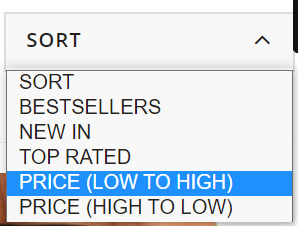
This makes sense since their purpose is to allow visitors to simply sort or narrow page content rather than offering alternative results and additional value (which is offered through faceted navigation). As such, filter typically produce duplicate results which should not be discoverable beyond the immediate moment. But this hard-and-fast rule doesn’t always apply perfectly in the real world. This is why we need to look at our individual industries and understand what’s important to our unique set of customers.
If we look at the world of gifting, we often see people shopping with a particular budget in mind. Therefore, terms like “birthday gift under £20” (40 m/s) or “Secret Santa gift under £10” (2.9k m/s) are reasonably common, and opening up relevant listing pages could be useful for shoppers.
Step 4: The technical steps
Facet taxonomies are hugely complex and the number of attributes that can be strung together increases with the size of the domain. We, therefore, need to carefully manage the flood gates and mitigate against any potential risks including crawl inefficiencies and link equity dilution.
We can do this by:
1. Avoiding thin/doorway pages by regularly re-assessing your product offering. For instance, you may consider there to be little value in creating a new listings page if you’re selling a very small range of low price point products. In this case, you may decide against opening up an additional Product Listing Page when you sell as few as 10 eligible products. However, this is not a fixed rule, so it’s quite possible that your criteria may be lower for particular product lines. Either way, these numbers will change over time. Consider seasonal trends, when new collections are launched, and when they become discontinued. Setting up a product retirement strategy to manage expired products and categories at scale in parallel with this step is also highly recommended.
2. Prevent content cannibalization by arranging selected facets according to their value and significance. “Size” is very important for some electrical goods like TVs, laptops, and cameras, but is less so for beauty accessories or vacuum cleaners. You must also make sure page content is distinctive and reflects the focus of your chosen facet(s). Refer to step 5 for more details.
3. Follow the sequence in which adjectives and facets are typically selected by your customers. This can vary depending on where your audience lives. So, whilst products generally have five or more distinguishable features, English vernacular determines that we use more than four adjectives (e.g. size + color + material + shape) to describe something.
4. Control the controllables by dealing with overlapping variations. This typically occurs when multiples co-exist and each exhibits good search metrics. For instance, it’s reasonable for someone to simultaneously look for several color and/or fabric combinations in the different ways below.
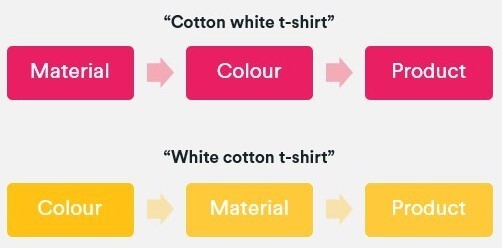
When this situation occurs, we should follow the same linguistic rules as above and choose a preferred sequence. In this case, it would be color + material + product type.
In comparison to the noindex tag suggested for on-page filters you should canonicalize unnecessary facets to their parent page (remembering that this is merely a hint and not a directive). This will enable you to control how crawlers deal with highly comparable result pages and will, therefore, help to prevent your site from being demoted in the SERPs. Dynamic search parameters should continue to be defined with a “noindex, nofollow” meta robots tag, disallowed in the robots.txt file, and configured through Google’s URL parameter tool (within your Search Console account) to tell crawlers the purpose of your parameters and how you would like them to be treated. This is a helpful guide on parameter handling for Googlebots, but bear in mind that this last tip won’t influence how Bing or Yahoo user-agents interpret these pages.
5. Open your facets in phases and cultivate it into a test-and-learn process. This will enable you to identify issues a lot sooner and implement facet-wide solutions in a timely manner. Without having to unravel these additional layers of complexity, problems such as crawl inefficiencies, PageRank dilution, or excessive indexation can be swiftly resolved.
To show you what this could look like, I’ve provided a phasing plan that was created for one of our e-commerce clients. Our research showed a significant SEO opportunity for opening up some of the facets and filters: potential +£263Kpcm for the “colour + type” facet (UK):
What’s more, when we extended our forecast to include other facet combinations, we calculated an additional revenue opportunity of up to +£207K/pcm (before filtering out combinations with no products offering).
Step 5: Optimize your facet URLs
Optimize your new facet category URLs to establish relevancy for your selected search terms. The key on-page elements to focus on include:
URL
Page title
Breadcrumb anchor texts
H tags
Content snippets (e.g. introductory text and FAQ copy)
Image ALT texts
Product names
Link out to similar facet category pages (i.e. via a “You May Also Like” feature box)
David’s Bridal is a good example of a retailer that has done this well. Looking back at the ‘Long Sleeve Wedding Dress’ Product Listing Page, we can see that they’ve curated unique content and followed fundamental optimization tactics on the landing page in a way that feels helpful to the user.
URL: davidsbridal.com/long-sleeve-wedding-dresses
Page Title: Long Sleeve Wedding Dresses & Gowns | David's Bridal
Meta Description: Do you dream of wearing a long sleeve wedding dress on your big day? Shop David's Bridal wide variety of wedding gowns with sleeves in lace & other designs!
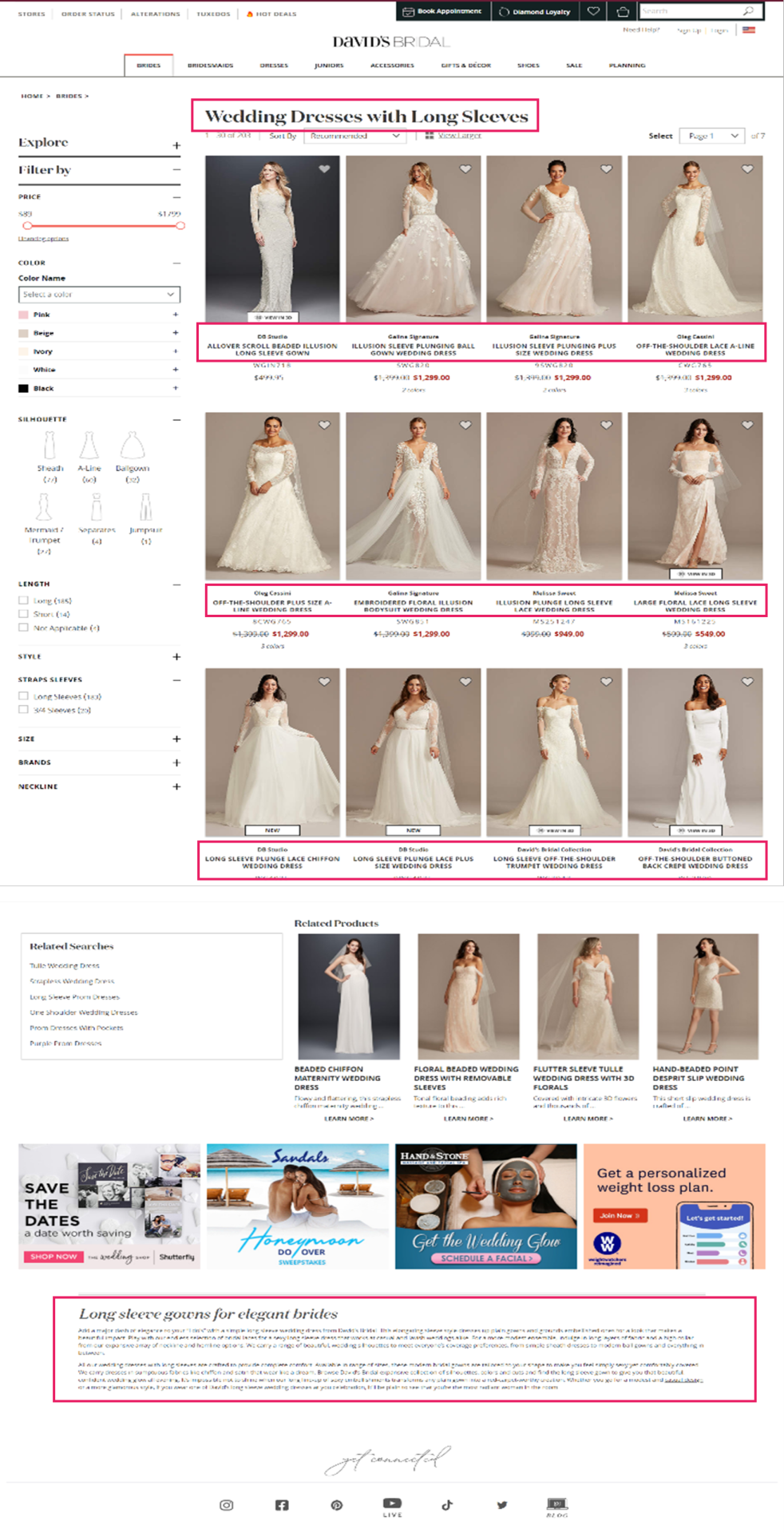
6. Provide accessibility and build page authority
Once you’ve opened up your new facet Product Listing Pages, you need to begin cultivating link equity towards them. This will ensure that they don’t exist as orphan URLs with no PageRank:
Ensure they’re referenced in your product XML sitemap.
If you have one feature per facet URL, then add them to your faceted navigation across CLP and Product Listing Page pages.
If you have two or more features per facet URL, then create a “Popular Searches” or “Related Searches” option within your CLPs.
Utilize your mega menu to showcase your new category landing pages. This will not only allow you to direct a large proportion of link equity, but it will also secure the highest click-through rate amongst your visitors.
Integrate your editorial strategy by creating engaging content with in-copy links. Think about how you can use descriptive long-tail anchor text about the Product Listing Page you want to link to rather than relying on “click here” or “see more”.
Connect to them via href links so you’re not solely relying on links from the main navigation or content hyperlinks. As this is difficult to do at scale, it can be done through modules such as “related categories”, “other subcategories”, “related products”, etc.
Devise strategic outreach campaigns that will secure quality, external backlinks to them.
Implementing this holistic and robust strategy will help you to secure exponential growth from your new commercial landing pages.
Conclusion
There is a great deal of organic opportunity that exists within your faceted navigation if you begin to leverage mid- and long-tail search terms.
Seek out the opportunity from extended keyword research and competitor analysis before deciding which variants fulfill consumer demands and deliver optimal organic sessions and onsite conversions. Configure a single faceted URL for each opportunity and open them up for crawl and indexation. Ensure PageRank is distributed to them (both internally and externally) and develop your landing page content in line with quality optimization practices. This approach will help you to avoid having crawl inefficiencies, over indexation, cannibalization, or having thin doorway pages. In turn, your website will be better suited to attract highly-targeted users and guide them down the purchase funnel.
Maximizing UX and reducing reliance on other marketing channels means that your faceted navigation can truly deliver organic ROI. We have seen this work for our clients.
0 notes